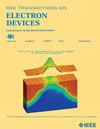Charge Carrier Lifetime and Trap States in Novel Pure-Boron-Based Ultrashallow p – n Junctions
IF 2.9
2区 工程技术
Q2 ENGINEERING, ELECTRICAL & ELECTRONIC
引用次数: 0
Abstract
Trap states and carrier transport parameters are critical to the performance of p–n-junction-based photodetectors. This study investigates ultrashallow p–n junctions for ultraviolet and low-energy particle detection fabricated using chemical vapor deposition-based pure-boron deposition (CVD-PB) with a junction depth only tens of nanometers, in comparison, also using ion implantation (IMP), epitaxy (EPI), and vacuum evaporation (VEP). Deep-level photothermal spectroscopy (DLPTS) and homodyne photocarrier radiometry (HoPCR) were used to analyze charge carrier dynamics, including charge carrier lifetime and trap states. A phenomenological theoretical model for HoPCR signals was developed to explain trap-state-modulated carrier transport dynamics. CVD-PB junctions demonstrated long recombination lifetimes in the doping layer (新型纯硼基超浅p - n结的载流子寿命和阱态
阱态和载流子输运参数对基于pn结的光电探测器的性能至关重要。本研究采用化学气相沉积纯硼沉积(CVD-PB)技术制备了用于紫外和低能粒子检测的超浅p-n结,其结深仅为数十纳米,与离子注入(IMP)、外延(EPI)和真空蒸发(VEP)技术进行了比较。利用深能级光热光谱(DLPTS)和纯差光载流子辐射测量(HoPCR)分析载流子动力学,包括载流子寿命和阱态。建立了HoPCR信号的现象学理论模型来解释陷阱态调制载流子输运动力学。CVD-PB结在掺杂层($7.09~\pm ~0.01~\mu $ s)和块体($35.80~\mu $ s)中表现出较长的复合寿命,与高能离子注入(HE-IMP)结($5.68~\pm ~0.58$和$36.10~\mu $ s)相当。EPI和VEP结具有较短的载流子复合寿命(分别为1.95~ 0.17美元和0.63~ 0.03~ 0.03美元)。DLPTS在EPI结处发现了一个活化能为0.09 eV的电子陷阱,捕获截面为7.52\乘以10^{-{20}}~\pm ~6.82\乘以10^{-{21}}$ cm2;在CVD-PB和HE-IMP连接处未观察到可检测到的陷阱。模拟结果表明,EPI结在10 V时的暗电流是CVD-PB和HE-IMP的两倍,光电流降低15%。与HE-IMP ($3.25~\mu $ A/cm ${}^{{2}}$)和EPI ($51.77~\mu $ A/cm ${}^{{2}}$)相比,CVD-PB在5 V反向偏置且没有光电子学中常用的典型保护环设计时表现出最低的暗电流($0.95~\mu $ A/cm ${}^{{2}}$)。
本文章由计算机程序翻译,如有差异,请以英文原文为准。
求助全文
约1分钟内获得全文
求助全文
来源期刊

IEEE Transactions on Electron Devices
工程技术-工程:电子与电气
CiteScore
5.80
自引率
16.10%
发文量
937
审稿时长
3.8 months
期刊介绍:
IEEE Transactions on Electron Devices publishes original and significant contributions relating to the theory, modeling, design, performance and reliability of electron and ion integrated circuit devices and interconnects, involving insulators, metals, organic materials, micro-plasmas, semiconductors, quantum-effect structures, vacuum devices, and emerging materials with applications in bioelectronics, biomedical electronics, computation, communications, displays, microelectromechanics, imaging, micro-actuators, nanoelectronics, optoelectronics, photovoltaics, power ICs and micro-sensors. Tutorial and review papers on these subjects are also published and occasional special issues appear to present a collection of papers which treat particular areas in more depth and breadth.
 求助内容:
求助内容: 应助结果提醒方式:
应助结果提醒方式:


